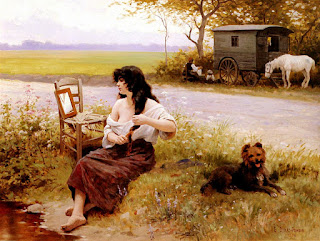Jules Breton: Harvesting the Oil Poppies
Paintings from 19th century France, from Neoclassic to Academic to Barbizon. Impressionism is not covered here.
Wednesday, January 31, 2018
Tuesday, January 30, 2018
Monday, January 29, 2018
After the Charge, Hanau (1896)
Henri-Georges-Jacques Chartier: After the Charge, Hanau
The Battle of Hanau took place during the War of the Sixth Coalition and resulted in a tactical victory for the French.
Sunday, January 28, 2018
Saturday, January 27, 2018
The Daughters of Atlas (1896)
Paul Alexandre Alfred Leroy: The Daughters of Atlas
Traditionally known as the Pleiades, the seven daughters of the titan Atlas and the sea nymph Pleione were nymphs in Artemis' train and, together with the seven Hyades, were the caretakers of the infant Bacchus. When Atlas was forced to hold the heavens on his shoulders, Zeus transformed the Pleiades into doves, then stars, to keep their father company in the sky (and to keep the daughters away from desiring men). Beyond the evident beauty of the maidens, Le Roy's work lacks a direct narrative connection with the mythological tale—or the work of Le Roy's fellow artists, such as William Bouguereau, who painted the daughters in more expected ways, floating in a star-filled sky, their loose tresses covering their supple bodies. Rather than employing Greco-Roman overtones, Le Roy's Pleiades are dark-haired huntresses, wearing cloth woven with tribal patterns, keenly watching for prey, waiting to release sharp arrows and long spears to add to their kill of a young gazelle. Contemporary audiences appreciated this mixture of exotic beauty and wild strength and how the work's Orientalist elements innovated the well-known tale and its visual tropes. The writer Thiébault-Sisson thrilled over Les Filles d'Atlas, "girls who dominate the plains" set against a realistically depicted arid desert, "orientalist landscape" that demonstrated Le Roy's "understanding of the Algerian environment that he loved. All is executed in a harmonious and soft quality, and one wonders at the marvel of the nudes with their fresh and pink complexions". [Sotheby's]
Friday, January 26, 2018
Thursday, January 25, 2018
Wednesday, January 24, 2018
Tuesday, January 23, 2018
Monday, January 22, 2018
Sunday, January 21, 2018
Saturday, January 20, 2018
Friday, January 19, 2018
Thursday, January 18, 2018
William Bouguereau (1895)
William Bouguereau: Pleasant Burden
William Bouguereau: In Penitence
William Bouguereau: Just a Taste
Wednesday, January 17, 2018
The Reader (1895)
William Bouguereau: La Liseuse [The Reader]
In La Liseuse Bouguereau features a young peasant girl sitting on a simple stone bench, one schoolbook open in her hands and a small pile of others by her side. Many artists in the nineteenth century created idealized images of the simple, honest life of the peasant as a form of reassurance in the rapidly industrializing modern world. Every summer Bouguereau would travel to the country and after months of relentless painting, bring back six to eight finished canvases. He found his young models, including the present one, in towns such as La Rochelle, a seaport in western France on the Bay of Biscay. La Rochelle had strong personal associations for the artist, as not only the place of his birth, but also the town where he chose to spend the last years of his life. The model featured here appears in a number of Bouguereau's work from 1893 onwards, along with the sisters Jeanne and Marguerite. In La Liseuse she is pictured with a playful look on her face as she glances up from her studies. Bouguereau depicts the same subject in Distraction, yet even though the model is his housekeeper's daughter, he shows her as a middle-class young lady. [Sotheby’s]
Tuesday, January 16, 2018
Saturday, January 13, 2018
Friday, January 12, 2018
Thursday, January 11, 2018
Wednesday, January 10, 2018
Tuesday, January 9, 2018
Monday, January 8, 2018
Saturday, January 6, 2018
An Ouled Naïl Tribal Dancer (1895)
Georges Jules Victor Clairin: An Ouled Naïl Tribal Dancer
The Ouled Naïl are Algerian Berber tribespeople famous for their elaborate dress and dances.
Friday, January 5, 2018
Truth Coming out of the Well (1895)
Jean-Léon Gérôme: Truth Coming out of the Well,
Armed with a Whip to Punish Mankind
Monday morning usually greets the world like the woman in this painting by Jean-Léon Gérôme. The figure of truth emerges from a well holding a scourge with which to shame and punish humankind. The image makes literal reference to a saying by the ancient Greek philosopher Democritus (ca. 460 BC – ca. 370 BC): “Truth lies at the bottom of a well." Some have interpreted the painting as a reference to the Dreyfus affair, while others discuss the it in the context of a quote by Gérôme that "thanks to photography, Truth has finally left her well.” – [WTF Art History]
Thursday, January 4, 2018
Tuesday, January 2, 2018
Monday, January 1, 2018
Subscribe to:
Posts (Atom)




























